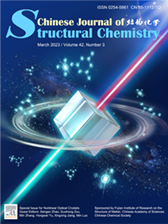
Recent advances in non-π-conjugated nonlinear optical sulfates with deep-UV absorption edge
Xu Chen, Yanqiang Li, Junhua Luo, Sangen Zhao* Submit a Manuscript
Sangen Zhao*, Guohong Zou*, Min Zhang*, Hongwei Yu*, Xingxing Jiang*, Min Luo*
ABSTRACT
Nonlinear optical (NLO) crystals are core materials in laser frequency-conversion technique, and the requirement on the laser wavelength varies from one application to another. Now, the commercial NLO crystals, e.g., KDP, LBO, BBO, KTP, AgGaS2, ZnGeP2, et al., have prevailed in ultraviolet (UV)/visible and near-/mid-infrared region for decades, and the laser in deep-ultraviolet (DUV) region (λ < 200 nm) has been also achieved by KBBF crystal. With the recent development of science and technology, new requirements, including further shorter/longer wavelength, higher power, better optical qualities and more miniaturization, have been being posed on laser technique. Consequently, to satisfy these growing demands, the extension of new NLO crystals system with better performance, directional structural design and controllable synthesis of NLO crystals based on deep understanding of its structural-property relationship, and novel NLO effect discovery and further design on laser device of novel principles, are still one of the hottest topics in the field of optoelectronic functional materials.
This special issue contains eight papers, in which one highlight, one perspective, one research article and five reviews are included. Among them, four papers focus on the novel materials exploration of UV/DUV NLO crystals, two are related to the structural design on the mid-/far-infrared NLO crystals, and two are related to the discovery of novel NLO effect. We would like to express our sincere thanks to all the authors for their submission of such interesting works to this special issue. A brief summary of these eight papers is provided as follows:
Firstly, in highlight “A promising Van der Waals two-dimensional nonlinear optical crystal NbOCl2 for ultrathin quantum light source”, a research progress about low-dimensional NLO materials is highlighted. Stable monolayer and few-layer NbOCl2 flake crystals were prepared by mechanical exfoliation method, in which layer-independent bandgap (~1.6 eV) and NLO response (~200 pm/V) are manifested. By NbOCl2 flakes, spontaneous parametric down-conversion (SPDC) with a high performance value (9800 GHzW-1m-1) @ the detected coincidence rate of 86HZ is detected. Remarkably, the lowest measured wafers were as thin as 46 nm, which is the thinnest SPDC source reported by so far.
In perspective “Free-oxygen: A promising functional unit for strengthening electron-phonon coupling effect”, based on a recent research presenting a multi-phonon coupling strategy to break the limitation of inherent fluorescence, the microscopic mechanism of assembled-dimension “free-oxygen”-centered tetrahedron in strengthening electron-coupling interaction is verified. Accordingly, such a concept is extended to the strategy of “free-cation” to promote the multi-phonon-assisted lasing.
In short communication “Structural design and characterization of a new chalcone molecular derivative crystal DMNC with high second-order nonlinear coefficient”, by introducing the naphthalene ring and methoxy, a new type of nonlinear optical crystal DNMC was rationally designed, synthesized and grown. DNMC has a phase-matching NLO response of 2.3 times higher than that of the benchmark OH1 crystal, which exhibits potential NLO application in THZ region.
In review “Fluorooxoborates: A precious treasure of deep-ultraviolet nonlinear optical materials”, the synthesis, structures, and properties of representative crystals in the research history of fluorooxoborates are introduced and summarized. By systematic structural and performance investigation on fluorooxoborates, it is proposed to be a precious treasure for the exploration of DUV NLO crystals, and the opportunities and challenges of the future research in this DUV NLO crystal system are put forward.
In review “Salt-inclusion chalcogenides: Double functional moieties design strategy toward excellent nonlinear optical materials”, structural analysis is implemented on 52 compounds with representative structural characteristic in salt-chalcogenide family. By taking the dimensions of host and guest moieties as criterion, the compounds are categorized. Accordingly, the structure-property relationship of NLO properties is discussed, and the perspective of this materials system is concluded.
In review “Recent advances of inorganic phosphates with UV/DUV cutoff edge and large second harmonic response”, the structure-property relationship of the representative UV/DUV NLO phosphates is analyzed, and the atomic-scale mechanism of the contradiction between the wide bandgap and large NLO response as well as large birefringence is clarified. Finally, the strategy to improve the NLO response and birefringence via fluoride ion introduction is proposed.
In review “Recent progress in ultraviolet and deep-ultraviolet nonlinear optical aluminoborates”, in terms of compositions, the aluminoborates (ABOs) are grouped into three types: (i) aluminum oxyborates, (ii) alkali/alkaline earth metal aluminoborates and (iii) alkali/alkaline earth metal aluminoborate fluorides and fluoroaluminoborates. The synthesis, structural characteristics and structure-performance relationship of their NLO response are discussed. Finally, the perspective of this material family in NLO application is discussed.
In review “Recent advances in non-π-conjugated nonlinear optical sulfates with deep-UV absorption edge”, a comprehensive overview about the non-π-conjugated UV/DUV NLO sulfates is provided. From the aspects of synthesis methods, crystal structures, thermal stability and optical performance, the “synthesis-structure-performance” relationship is discussed, and accordingly some prospects for the exploration of non-π-conjugated NLO sulfates with DUV cutoff edge, high thermal stability, enhanced NLO response and large birefringence are given.





